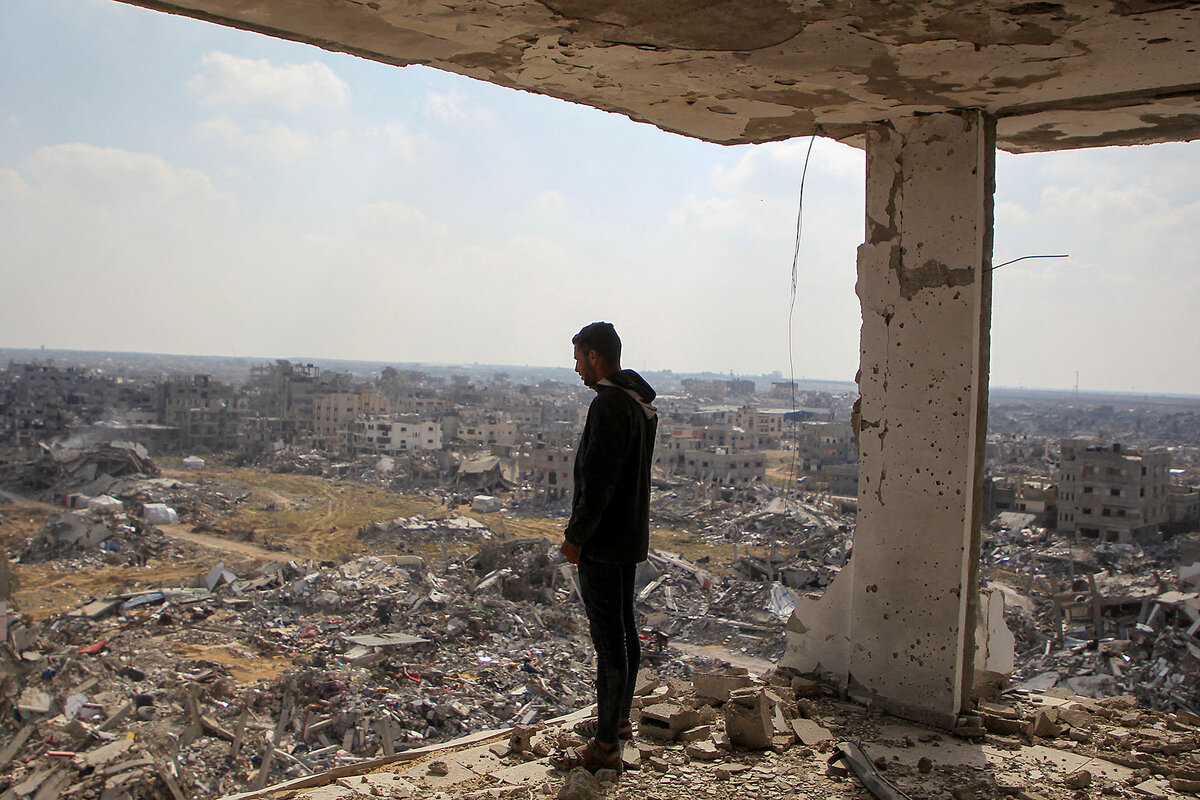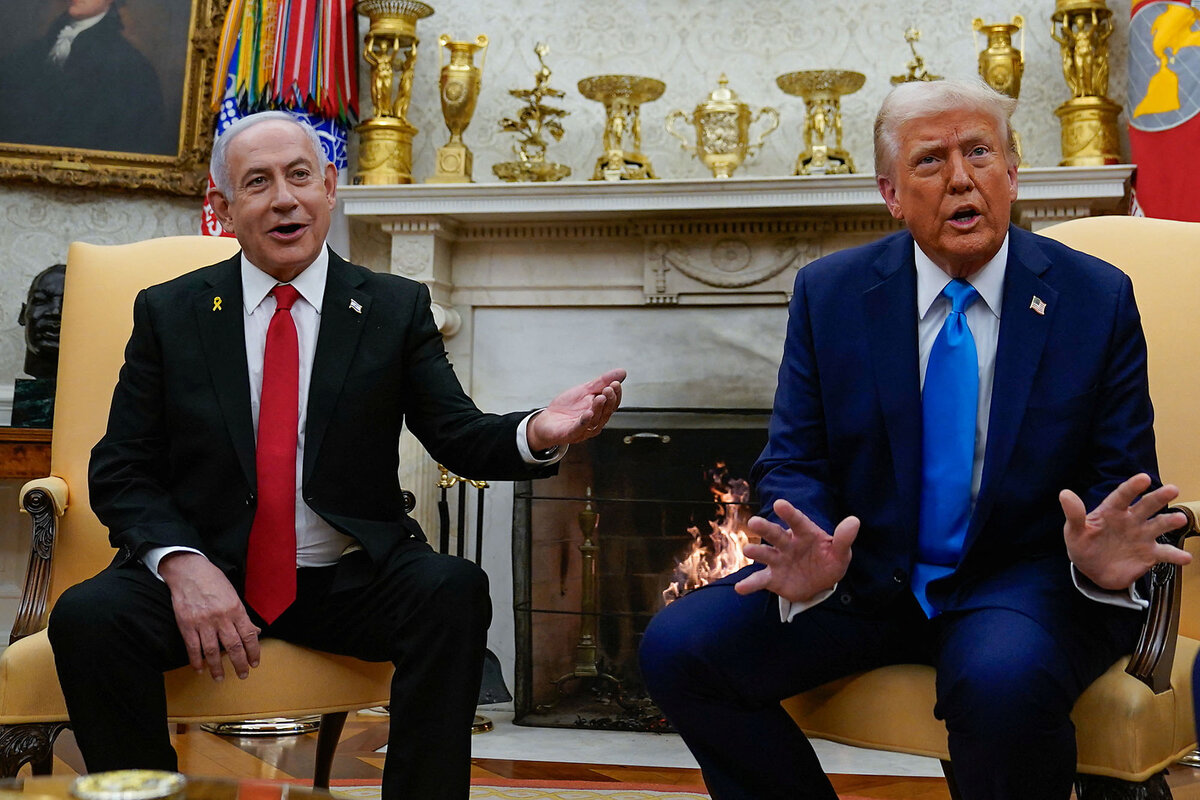Trump’s plan for Gaza ridiculed as unserious. So why did he float it?
Loading...
| Washington
Greenland, the Panama Canal, Canada as the 51st state – and now a rebuilt and redeveloped Gaza Strip?
President Donald Trump’s bombshell proposal Tuesday for the United States to “own” a Gaza depopulated of its 2 million Palestinians and make it the “riviera of the Middle East” is the latest – and perhaps most shocking – example of a new American manifest destiny.
All of President Trump’s expansionist musings have been received by an incredulous world with varying degrees of suspicion, dismissiveness, and rejection. But the idea of an imperial America taking over a piece of Palestinian homeland – with American boots on the ground if necessary – and refashioning it into a glitzy Mediterranean playground is eye-popping.
Why We Wrote This
While President Donald Trump has ridiculed past U.S. military deployments and nation-building efforts, he has consistently been drawn to Mideast diplomacy. But his proposal to “own” and develop the Gaza Strip and displace its population has many questioning how serious he is.
And not productive, say some Middle East experts.
“This is the least serious of all of these ideas” of territorial expansion and U.S. ownership, “but in the moment it is the most destructive,” says Aaron David Miller, who has served as a senior adviser on Arab-Israeli issues to both Republican and Democratic administrations.
“It’s done to disrupt; it’s done to keep people off balance,” he adds, “but all it really does is undermine U.S. allies and partners and make it harder to realize [Mr. Trump’s] own goals for the region.”
Confusion over the proposal reigned Wednesday as Trump administration officials walked back the president’s comments that U.S. troops could be used to secure the area and insisted that any Palestinian displacement would be temporary.
As with Mr. Trump’s other proposals, the Gaza idea immediately drew speculation that it is another of the president’s bright shiny objects designed primarily to distract attention from other events and issues.
For example, Mr. Trump laid out his Gaza proposal at a joint press conference with Israeli Prime Minister Benjamin Netanyahu – whose White House visit had been expected to focus on Phase 2 of the Gaza ceasefire and hostage deal and U.S. efforts to keep it on track.
But the ceasefire was relegated to also-ran status as journalists’ questions sought to flesh out the president’s bombshell proposal.
Some note that the Gaza plan was floated in a Washington reeling from a dizzying remaking of the federal government that some experts (and Democratic lawmakers) are calling a coup.
Yet others counter that simply dismissing the brash dealmaking president’s ideas as whimsy has not panned out well – as Greenland has learned as Mr. Trump presses his plan to acquire the Arctic island, and as Panama learned from Secretary of State Marco Rubio’s visit Saturday.
At the press conference, Mr. Netanyahu appeared enthusiastic about Mr. Trump’s Gaza plan – and lauded the president’s disruptive and “outside the box” foreign policy approach more generally.
“You cut to the chase; you say things others refuse to say,” the beaming Israeli leader said, addressing Mr. Trump. “After the jaws drop, people shake their heads and say, ‘You know, he’s right.’”
But rejection of the idea of the U.S. “owning” Gaza was otherwise widespread and swift. Most roundly criticized was the proposal to forcibly relocate Gaza’s residents to neighboring countries, including Jordan and Egypt.
Within hours, the Saudi Foreign Ministry issued a statement reaffirming the kingdom’s “unequivocal rejection of any infringement of the legitimate rights of the Palestinian people,” including “attempts to displace the Palestinian people from their land.”
In Washington, some lawmakers did not mince words.
“Trump’s proposal to push 2 million Palestinians out of Gaza and take ‘ownership’ by force if necessary is simply ethnic cleansing by another name,” said Democratic Sen. Chris Van Hollen of Maryland in a statement. “Congress must stand up to this dangerous and reckless scheme.”
Mr. Trump’s proposal left many observers puzzled as to why Gaza, a complex and multifaceted issue, would prompt the president to abandon some of his core critiques of recent Republican and Democratic administrations. Those include grandiose nation-building projects, and the deployment of U.S. troops to carry out regime change and deliver security.
The president will have an opportunity to publicly address some of these questions when Jordan’s King Abdullah visits the White House next week.
But the Gaza proposal should be seen in the context of a president who believes fervently in his own power of persuasion, who disdains traditional diplomacy, and whose Mideast envoy is a businessman with no experience in that field.
Mr. Trump says decades of unproductive U.S. diplomacy in the Middle East have failed to deliver peace and prosperity. But outside of his close circle of advisers, few see much promise for his Gaza plan.
“What we’re seeing in operation is the mindset of an opportunistic real estate developer who looks at a destroyed Gaza and its setting and sees a potential for moving everybody out and getting others to pay for a big beautiful new project,” says Dr. Miller, now a senior fellow at the Carnegie Endowment for International Peace.
He notes that the president presented his Gaza proposal reading from notes, not off the top of his head. “It’s clear he’s been thinking about this for a long time,” he says. “But it’s a proposal that focuses on Gaza first,” instead of laying the foundation among allies and partners for a viable regional plan.








